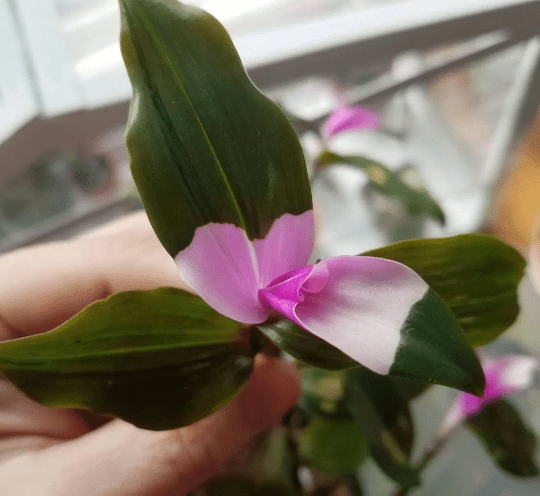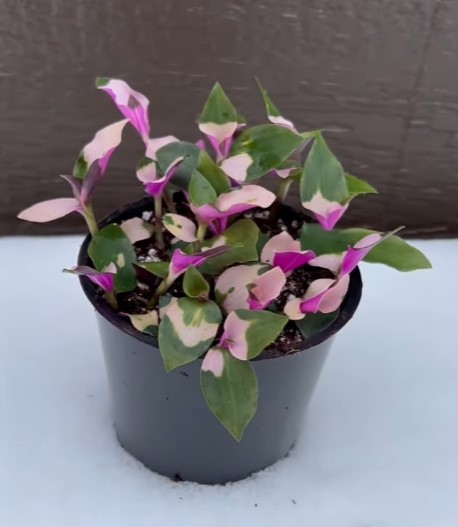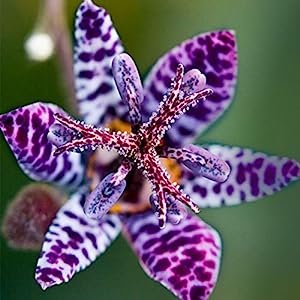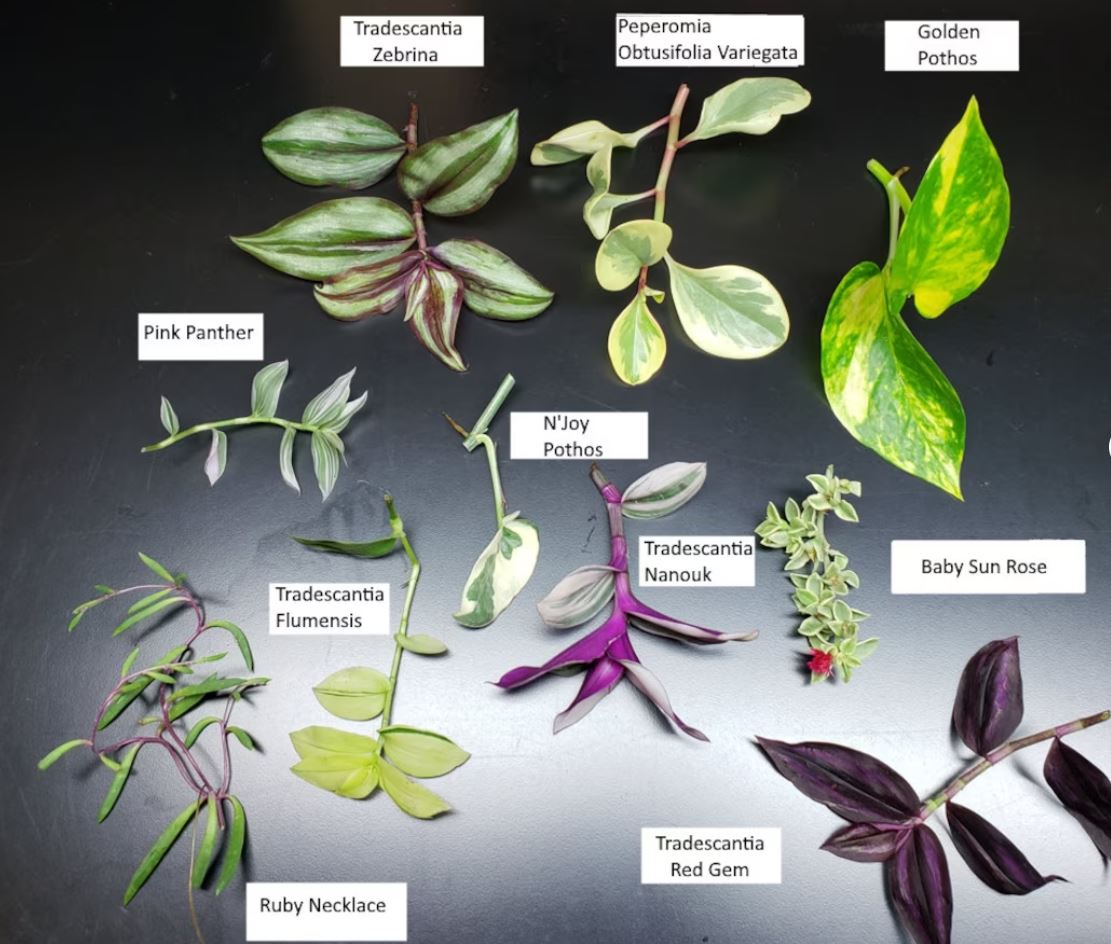Tradescantia Blushing Bride, also known as Tradescantia Spiderwort andersoniana, is a popular houseplant known for its striking pink and white variegated leaves. This plant is native to the southern United States and Mexico, where it grows in damp, shady areas.
All You Need To Know About Caring For Your Blushing Bride!
Tradescantia andersoniana from the plant family also named, Wandering Jew, is a type of plant that is known for its ability to change color in response to different temperatures. The plant’s leaves will turn a pink or red color when exposed to colder temperatures. This is a natural response by the plant to protect itself from the cold. The pigmentation change is a natural process, in order to prevent damage to the cells in the leaves. This is a common adaptation in many plants that live in cold environments, as it helps them to conserve heat and protect themselves from frost damage.
Here are some tips on how to take care of your Tradescantia Blushing Bride.
Light
Tradescantia Blushing Bride prefers bright, indirect light. It can tolerate some direct sunlight, but too much sun can cause the leaves to fade or burn. If you don’t have a bright spot in your home, you can supplement the light with a grow light.
Water
It should be kept consistently moist, but not waterlogged. Allow the top inch of soil to dry out before watering again. It’s important to not let the plant sit in standing water, this can lead to root rot.
Humidity
Tradescantia andersoniana prefers higher humidity levels, but it can tolerate normal household humidity. You can increase humidity around the plant by placing a tray of water near it, misting it regularly, or using a humidifier.
Temperature
Tradescantia Blushing Bride prefers temperatures between 60 and 75 degrees Fahrenheit. It can tolerate temperatures as low as 50 degrees Fahrenheit, but it should be protected from drafts and cold temperatures. Is your Tradescantia Blushing Bride not pink? It could be that it isn’t cold enough to blush and it is reverting back to green due to it’s habitat.
Soil
Tradescantia Blushing Bride prefers well-draining, peat-based potting mix. You can also mix perlite or coarse sand to improve drainage.
Fertilizer
Blushing Bride should be fertilized every four to six weeks during the growing season with a balanced, water-soluble fertilizer.
Pruning
It is a fast-growing plant, so it may need to be pruned to control its size. Prune the plant back to the desired size, and it will quickly produce new growth.
Tradescantia Blushing Bride Propagation
Blushing Bride can be easily propagated by taking stem cuttings and rooting them in water or soil.

Pests and Diseases
It is generally a healthy plant, but it can be susceptible to mealybugs, spider mites, and thrips. To prevent these pests, keep the plant clean and dry, and spray it with a mixture of water and dish soap. If your plant develops a fungal or bacterial disease, remove and dispose of any affected leaves and treat the plant with a fungicide or bactericide.
Conclusion
Overall, Tradescantia Blushing Bride is a low-maintenance, easy-to-grow houseplant that adds a touch of color to any room. With proper care, it will thrive and produce beautiful pink and white variegated leaves. It’s a perfect plant for beginners or those who have limited space but still want to bring some nature inside.
Where To Buy Tradescantia Blushing Bride?
Click Here to purchase your very own Blushing Bride plant.

Blushing begins when temperatures drop in the fall throughout winter and early spring. During the summer months the pink blush begins to fade to light green.
Blushing Bride Flawless Cutting

Tradescantia Blushing Bride Indoor Care
To care for it indoors, follow these steps:
- Light: Tradescantia Blushing Bride prefers bright, indirect light. Place it near a window that gets plenty of natural light, but avoid direct sunlight which can cause the leaves to fade.
- Watering: Keep the soil consistently moist, but not waterlogged. Allow the top inch of soil to dry out before watering again. Be sure to avoid getting water on the leaves, as this can cause them to rot.
- Humidity: Tradescantia Blushing Bride likes high humidity, so you may want to place a tray of water near it or use a humidifier.
- Temperature: Tradescantia Blushing Bride prefers temperatures between 60 and 75 degrees Fahrenheit (15-24 degrees Celsius). Avoid placing it near drafts or air conditioning vents.
- Fertilizer: Fertilize your Tradescantia Blushing Bride once a month during the growing season with a balanced liquid fertilizer.
- Pruning: Prune as needed to control the size and shape of the plant.
- Pests: Keep an eye out for common indoor plant pests such as spider mites, mealybugs, and whiteflies. If you notice any, treat them promptly with an insecticidal soap or neem oil.
What can i do for my tradescantia blushing bride when it has yellow brown spots?

Brown spots or yellowing on Tradescantia Blushing Bride can be caused by a variety of factors, including pests, disease, or environmental stress. Here are a few steps you can take to address the issue:
- Check for pests: Inspect the plant for signs of common indoor plant pests such as spider mites, mealybugs, and whiteflies. These pests can cause brown spots on the leaves as well as other damage. If you notice any pests, treat them promptly with an insecticidal soap or neem oil.
- Assess watering: Overwatering or underwatering can cause brown spots on the leaves. Make sure you are watering your Tradescantia Blushing Bride correctly by allowing the top inch of soil to dry out before watering again.
- Check light: Tradescantia Blushing Bride prefers bright, indirect light. If the plant is getting too much direct sunlight, the leaves may develop brown spots. Move it to a location with more filtered light.
- Check humidity: Tradescantia Blushing Bride likes high humidity. If the air is too dry, it can cause brown spots on the leaves. Try placing a tray of water near the plant or using a humidifier to increase the humidity.
- Disease: Brown spots on leaves can also be caused by disease. If you suspect that your plant may be infected with a disease, it’s best to remove the affected leaves and dispose of them.
If the problem persists, it may be best to consult with a professional to determine the exact cause and appropriate treatment.
What tips can you give to help make a tradescantia blushing bride change to pink colors?
Tradescantia Blushing Bride is known for its beautiful pink and white variegated leaves. If you want to encourage the plant to produce more pink color, here are a few tips to try:
- Provide bright, indirect light: Tradescantia Blushing Bride prefers bright, indirect light. Place it near a window that gets plenty of natural light, but avoid direct sunlight which can cause the leaves to fade. Pink pigmentation is often more prominent in plants that are exposed to higher light levels.
- Control temperature: Tradescantia Blushing Bride prefers temperatures between 60 and 75 degrees Fahrenheit (15-24 degrees Celsius). Keep the plant in a warm room and avoid exposing it to drafts or air conditioning vents.
- Fertilize: Feed your Tradescantia Blushing Bride regularly with a balanced liquid fertilizer, as this can help promote healthy growth and color.
- Prune: Prune as needed to control the size and shape of the plant. Pruning will also help to promote bushier growth and more pink color on the leaves.
- Assess humidity: If your Tradescantia Blushing Bride is in a dry environment, the leaves may lose some of their color. Try placing a tray of water near the plant or using a humidifier to increase the humidity.
It’s important to note that pink pigmentation in Tradescantia Blushing Bride can also be affected by genetics and some varieties will have more pink than others. Additionally, it’s important to note that even if you follow the tips mentioned, you should not expect a dramatic change, some plants may change slightly but not all of them will.
https://www.pinterest.com/pin/602004675210905313/




